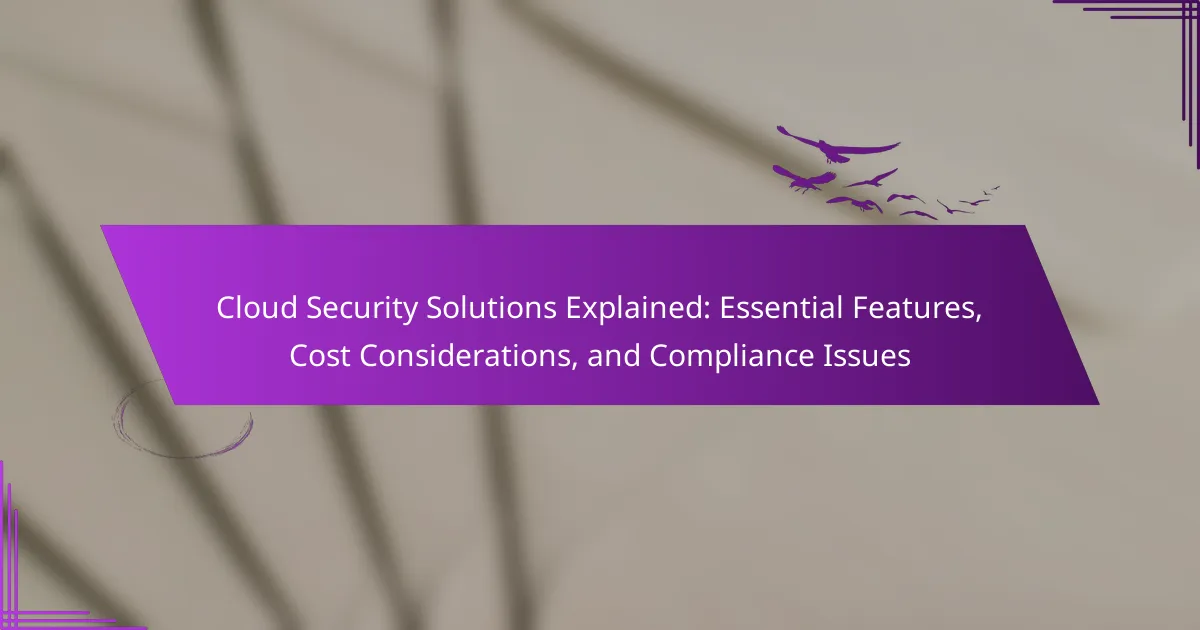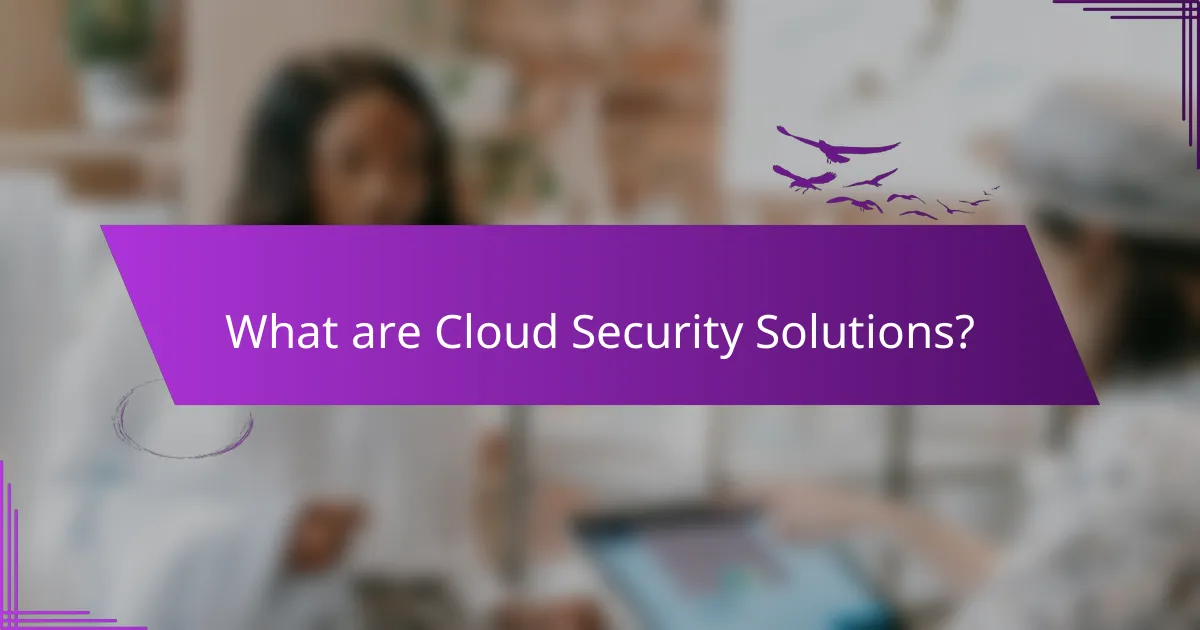
What are Cloud Security Solutions?
Cloud security solutions are measures designed to protect data, applications, and infrastructures involved in cloud computing. These solutions include tools and services that secure cloud environments from threats such as data breaches and cyberattacks. They encompass various protective mechanisms, including encryption, identity management, and access controls. According to a 2021 report by Gartner, the global cloud security market is projected to reach $12.6 billion by 2025. This growth highlights the increasing importance of safeguarding cloud assets. Cloud security solutions also ensure compliance with regulations like GDPR and HIPAA, which mandate data protection standards.
How do Cloud Security Solutions protect data?
Cloud security solutions protect data through encryption, access controls, and continuous monitoring. Encryption secures data both in transit and at rest, making it unreadable to unauthorized users. Access controls ensure that only authorized personnel can access sensitive information, reducing the risk of data breaches. Continuous monitoring detects suspicious activities in real-time, allowing for quick responses to potential threats. Additionally, regular audits and compliance checks help maintain security standards and identify vulnerabilities. According to a report by Gartner, organizations that implement cloud security solutions can reduce the risk of data breaches by up to 60%.
What technologies are used in Cloud Security Solutions?
Cloud security solutions utilize various technologies to protect data and applications in the cloud. Key technologies include encryption, which secures data by converting it into a coded format. Identity and access management (IAM) systems control user access to resources. Firewalls and intrusion detection systems monitor and filter network traffic for threats. Multi-factor authentication (MFA) adds an extra layer of security during user login. Security information and event management (SIEM) systems analyze security alerts in real time. Data loss prevention (DLP) technologies protect sensitive information from unauthorized access. These technologies work together to create a robust security framework for cloud environments.
How do these technologies work together?
Cloud security solutions work together by integrating various protective measures to secure data and applications in the cloud. These technologies include encryption, identity and access management, and threat detection systems. Encryption protects data at rest and in transit, ensuring unauthorized users cannot access sensitive information. Identity and access management controls user permissions, allowing only authorized personnel to access specific resources. Threat detection systems monitor for suspicious activities, enabling rapid response to potential security breaches. Together, these technologies create a layered security approach, enhancing overall cloud security. This integration helps organizations comply with regulatory requirements and reduces the risk of data breaches.
Why are Cloud Security Solutions essential for businesses?
Cloud Security Solutions are essential for businesses to protect sensitive data and maintain compliance. They safeguard against cyber threats, including data breaches and ransomware attacks. According to a report by Cybersecurity Ventures, cybercrime is expected to cost the world $10.5 trillion annually by 2025. Cloud Security Solutions also ensure data integrity and availability, which are critical for business operations. Furthermore, they help organizations meet regulatory requirements, such as GDPR and HIPAA, by providing necessary security measures. Effective cloud security reduces the risk of financial loss and reputational damage. Thus, implementing these solutions is crucial for maintaining trust with customers and stakeholders.
What risks do Cloud Security Solutions mitigate?
Cloud security solutions mitigate risks such as data breaches, unauthorized access, and compliance violations. They protect sensitive information from cyber threats through encryption and access controls. These solutions also address vulnerabilities in cloud infrastructure that could lead to service disruptions. By implementing security measures, organizations can reduce the likelihood of data loss and financial penalties. Studies show that companies using cloud security solutions experience fewer incidents of data breaches compared to those without them. This effectiveness is supported by research from the Cybersecurity and Infrastructure Security Agency, which highlights the importance of robust cloud security practices.
How do Cloud Security Solutions enhance compliance?
Cloud security solutions enhance compliance by providing tools that help organizations meet regulatory requirements. They offer features such as data encryption, access controls, and audit trails. These features ensure that sensitive information is protected and only accessible to authorized users. Compliance frameworks often require documented evidence of data handling practices. Cloud security solutions facilitate this by maintaining comprehensive logs of user activities. They also provide automated compliance reporting, which simplifies the process of demonstrating adherence to regulations. Additionally, many cloud providers undergo regular third-party audits, ensuring their services meet industry standards. This transparency helps organizations trust that their compliance needs are being addressed effectively.
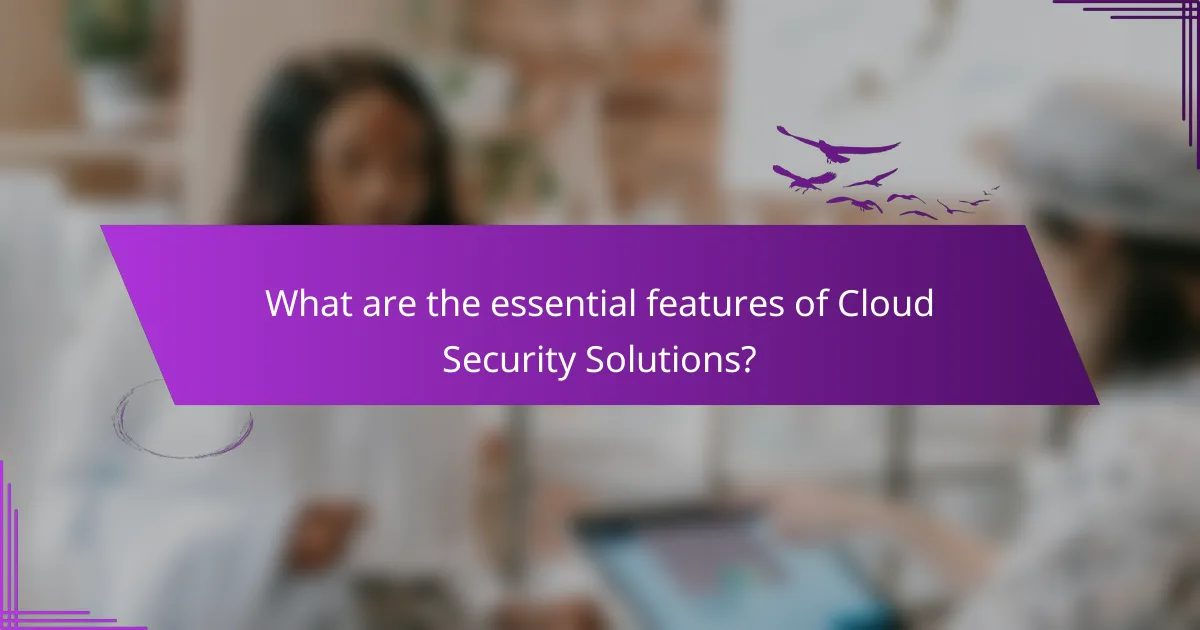
What are the essential features of Cloud Security Solutions?
Essential features of Cloud Security Solutions include data encryption, identity and access management, and threat detection. Data encryption protects sensitive information during transmission and storage. Identity and access management ensures that only authorized users can access cloud resources. Threat detection identifies and responds to potential security incidents in real-time. Additionally, compliance management helps organizations adhere to regulatory requirements. Multi-factor authentication adds an extra layer of security for user access. Regular security assessments and audits are crucial for maintaining security posture. These features collectively enhance the overall security of cloud environments.
How do encryption and data protection work in Cloud Security Solutions?
Encryption in cloud security solutions protects data by converting it into an unreadable format. This process ensures that only authorized users can access the original information. Data protection mechanisms also include access controls and authentication measures. These controls regulate who can view or modify data stored in the cloud.
Encryption algorithms, such as AES-256, are commonly used to secure data at rest and in transit. This means that data stored on servers and data being transmitted over networks are both protected. Additionally, cloud providers often implement key management systems. These systems manage encryption keys securely, preventing unauthorized access.
According to a report by the Cloud Security Alliance, 64% of organizations consider encryption a critical component of their cloud security strategy. This statistic highlights the importance of encryption in safeguarding sensitive information. Overall, effective encryption and data protection measures are essential for maintaining data confidentiality and integrity in cloud environments.
What types of encryption are commonly used?
Common types of encryption include symmetric encryption, asymmetric encryption, and hash functions. Symmetric encryption uses the same key for both encryption and decryption. Examples include AES and DES. Asymmetric encryption uses a pair of keys, a public key for encryption and a private key for decryption. RSA and ECC are prominent examples. Hash functions transform data into a fixed-size string, ensuring data integrity. SHA-256 is a widely used hash function. These encryption types are foundational for securing data in cloud environments.
How does data protection differ across platforms?
Data protection differs across platforms primarily due to varying security protocols and compliance requirements. Different platforms may implement distinct encryption methods for data at rest and in transit. For instance, cloud services often utilize AES-256 encryption, while on-premises solutions may rely on different standards. Additionally, data access controls can vary significantly; some platforms provide granular user permissions, while others offer broader access. Compliance with regulations like GDPR or HIPAA also influences data protection strategies, as platforms must adapt to specific legal frameworks. Ultimately, the choice of platform affects the overall effectiveness of data protection measures.
What role does identity and access management play in Cloud Security Solutions?
Identity and access management (IAM) is crucial for cloud security solutions. IAM ensures that only authorized users can access cloud resources. It involves managing user identities and controlling their access to data and applications. By implementing IAM, organizations can enforce security policies effectively. This reduces the risk of unauthorized access and data breaches. According to a study by Gartner, organizations that utilize IAM reduce security incidents by up to 50%. IAM also supports compliance with regulations such as GDPR and HIPAA by providing audit trails and access controls. Overall, IAM enhances the security posture of cloud environments significantly.
How can businesses implement effective identity controls?
Businesses can implement effective identity controls by adopting multi-factor authentication (MFA). MFA adds an extra layer of security beyond just a password. This approach requires users to provide two or more verification factors. These factors can include something they know, something they have, or something they are. Implementing MFA reduces the risk of unauthorized access by 99.9% according to Microsoft. Additionally, businesses should regularly review and update user access rights. This ensures that employees only have access to the information necessary for their roles. Conducting periodic audits of user accounts can help identify and remove inactive or unnecessary accounts. Training employees on the importance of identity security is also crucial. Educated employees are less likely to fall for phishing attacks. By combining these strategies, businesses can establish a robust identity control system.
What are the best practices for managing access rights?
The best practices for managing access rights include implementing the principle of least privilege. This principle ensures that users only have the access necessary to perform their job functions. Regularly reviewing and updating access rights is crucial. This practice helps identify and revoke unnecessary permissions. Utilizing role-based access control (RBAC) streamlines the management process. RBAC assigns access rights based on user roles, reducing complexity. Multi-factor authentication (MFA) adds an extra layer of security. MFA requires users to provide multiple forms of verification before accessing sensitive information. Logging and monitoring access activities is essential for detecting unauthorized access. This practice enables organizations to respond swiftly to potential breaches. Training employees on security policies enhances overall awareness. Educated users are less likely to expose access rights to risks.
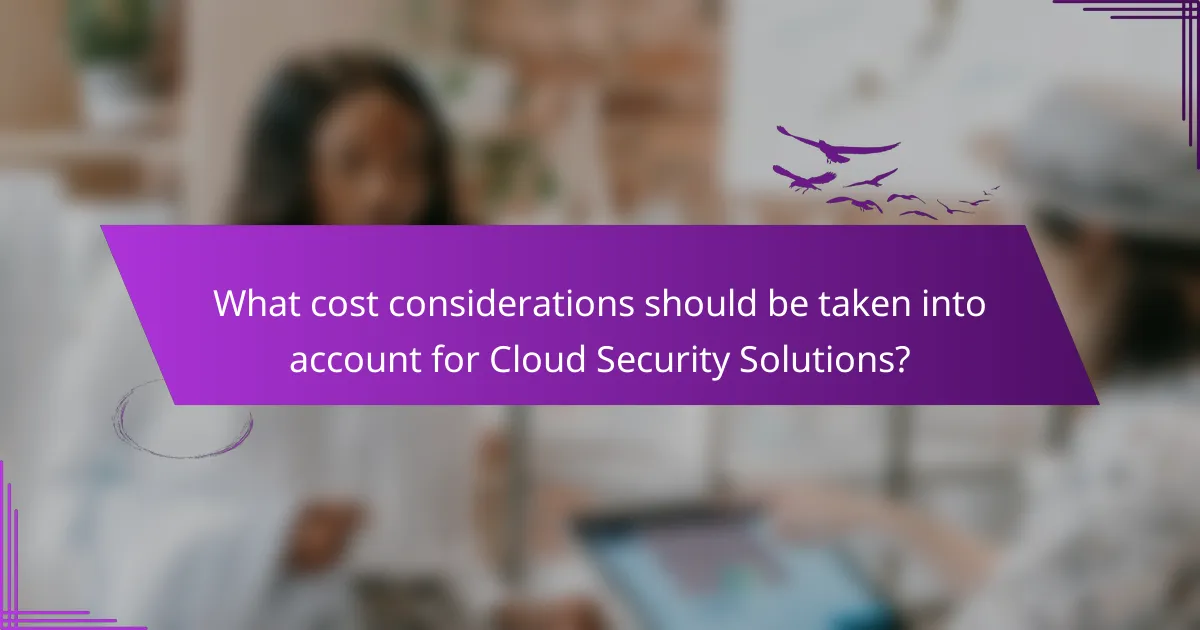
What cost considerations should be taken into account for Cloud Security Solutions?
Cost considerations for Cloud Security Solutions include subscription fees, implementation costs, and ongoing maintenance expenses. Subscription fees vary based on service levels and features. Implementation costs cover integration with existing systems and user training. Ongoing maintenance expenses involve regular updates and security monitoring. Organizations should also account for potential data breach costs, which can be significant. Compliance requirements may lead to additional costs for audits and certifications. Overall, understanding these factors helps in budgeting for effective cloud security.
How do pricing models for Cloud Security Solutions vary?
Pricing models for Cloud Security Solutions vary primarily in structure and cost. Common models include subscription-based, pay-as-you-go, and tiered pricing. Subscription-based models charge a fixed fee for access over a specific period. Pay-as-you-go models charge based on actual usage, allowing flexibility for varying workloads. Tiered pricing provides different service levels at different price points, catering to diverse business needs.
According to a report by Gartner, 60% of organizations prefer subscription models for predictable budgeting. Additionally, the pay-as-you-go model appeals to startups and small businesses due to its cost-effectiveness. The tiered approach is beneficial for larger enterprises that require customized solutions. Each model addresses specific customer requirements and financial capabilities.
What are the common pricing structures?
Common pricing structures for cloud security solutions include subscription-based, pay-as-you-go, and tiered pricing. Subscription-based pricing charges a fixed fee at regular intervals, often monthly or annually. This model provides predictable costs and access to services.
Pay-as-you-go pricing allows users to pay only for the resources they consume. This structure is flexible and can lead to cost savings for variable usage patterns. Tiered pricing offers different service levels at varying prices. Each tier typically includes a set of features, with higher tiers providing more advanced capabilities.
These pricing models cater to diverse business needs. They enable organizations to choose a structure that aligns with their budget and usage requirements.
How can organizations estimate their budget for Cloud Security Solutions?
Organizations can estimate their budget for Cloud Security Solutions by assessing their specific security needs and evaluating potential service providers. They should consider the scale of their operations and the sensitivity of the data they handle. Analyzing existing security measures can help identify gaps that need addressing. Organizations must also factor in compliance requirements, which can influence costs.
Comparing pricing models of different cloud security vendors is essential. Many providers offer tiered pricing based on features and support levels. Organizations should also account for additional costs, such as training and integration with existing systems.
Industry reports indicate that cloud security spending is projected to grow significantly, reflecting the increasing importance of cybersecurity. According to a report by Gartner, global spending on cloud security is expected to reach $12.6 billion in 2022. This trend underscores the necessity for organizations to budget adequately for these solutions.
What are the potential hidden costs associated with Cloud Security Solutions?
Potential hidden costs associated with Cloud Security Solutions include unexpected fees for data transfer and storage. Organizations may incur additional charges for exceeding bandwidth limits. Licensing fees for security software can also add to overall costs. Compliance-related expenses may arise from audits and certification processes. Training staff on new security protocols can lead to increased operational costs. Integration with existing systems often requires additional investment. Downtime caused by security incidents can result in lost revenue. Finally, there may be costs related to third-party security assessments and consultations.
How do compliance requirements impact costs?
Compliance requirements increase costs for businesses. They necessitate investments in technology, personnel, and processes. Organizations must often implement specific security measures to meet these regulations. This can include advanced encryption, regular audits, and employee training programs. The expenses associated with these measures can be significant. For example, a study by the Ponemon Institute found that companies spend an average of $5.47 million annually on compliance-related costs. Non-compliance can lead to fines and legal fees, further increasing overall expenses. Thus, compliance requirements directly influence the financial landscape of organizations.
What additional services may incur extra charges?
Additional services that may incur extra charges in cloud security solutions include advanced threat detection, compliance audits, and data encryption. These services often require specialized resources or tools. For instance, advanced threat detection may involve using machine learning algorithms, which can increase operational costs. Compliance audits typically necessitate expert consultations and can lead to additional fees. Data encryption services may also have costs associated with key management and storage solutions. Each of these factors contributes to the overall pricing structure of cloud security solutions.
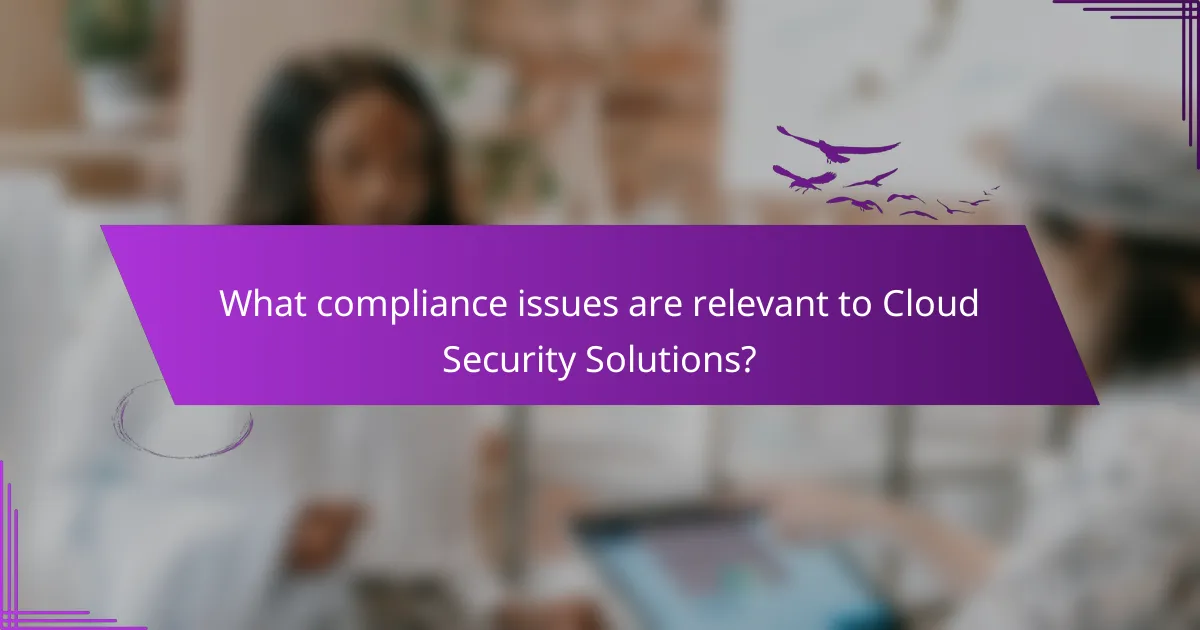
What compliance issues are relevant to Cloud Security Solutions?
Compliance issues relevant to Cloud Security Solutions include data protection regulations, industry standards, and contractual obligations. Organizations must adhere to regulations like GDPR, HIPAA, and CCPA. These regulations enforce strict guidelines on data handling and privacy. Industry standards, such as ISO 27001 and NIST, provide frameworks for managing security risks. Contractual obligations often arise from service level agreements (SLAs) with cloud providers. Non-compliance can result in hefty fines and legal repercussions. Regular audits and assessments help ensure adherence to these compliance requirements. Organizations should implement robust security measures to mitigate compliance risks effectively.
How do regulations affect Cloud Security Solutions?
Regulations significantly impact Cloud Security Solutions by establishing mandatory compliance standards. These regulations dictate how data must be protected and managed in cloud environments. For instance, the General Data Protection Regulation (GDPR) requires organizations to implement strict data protection measures. Compliance with such regulations often necessitates the adoption of advanced security technologies. This includes encryption, access controls, and regular security audits. Additionally, regulations can influence the design and architecture of cloud solutions. Providers must ensure their services align with legal requirements to avoid penalties. Thus, regulations shape the overall security posture of cloud environments and influence vendor choices.
What are the most common regulations impacting cloud security?
The most common regulations impacting cloud security include the General Data Protection Regulation (GDPR), the Health Insurance Portability and Accountability Act (HIPAA), and the Federal Risk and Authorization Management Program (FedRAMP). GDPR mandates strict data protection and privacy for individuals within the European Union. HIPAA establishes standards for protecting sensitive patient health information in the healthcare sector. FedRAMP provides a standardized approach to security assessment for cloud services used by federal agencies. Compliance with these regulations is crucial for organizations to avoid penalties and ensure data security.
How can businesses ensure compliance with these regulations?
Businesses can ensure compliance with regulations by implementing robust cloud security solutions. They should regularly assess their security measures against industry standards. Conducting audits helps identify gaps in compliance. Training employees on compliance requirements is essential. Utilizing automated compliance tools can streamline the monitoring process. Keeping documentation up-to-date is crucial for accountability. Engaging with legal experts ensures a thorough understanding of applicable regulations. Adhering to these practices minimizes the risk of non-compliance and potential penalties.
What best practices can organizations adopt for compliance in Cloud Security Solutions?
Organizations can adopt several best practices for compliance in Cloud Security Solutions. First, they should implement robust data encryption both in transit and at rest. This protects sensitive information from unauthorized access. Second, regular audits and assessments are essential. They help identify vulnerabilities and ensure adherence to compliance standards. Third, organizations must establish clear access controls. Limiting access to sensitive data minimizes the risk of breaches. Fourth, continuous monitoring of cloud environments is crucial. This helps detect anomalies and potential security incidents in real-time. Additionally, organizations should ensure that all cloud service providers comply with relevant regulations. This includes verifying certifications like ISO 27001 or SOC 2. Finally, employee training on security best practices enhances overall compliance. Educated staff can recognize and respond to security threats effectively. These practices collectively strengthen compliance in cloud security.
How can continuous monitoring improve compliance?
Continuous monitoring enhances compliance by providing real-time visibility into security controls and policy adherence. This proactive approach allows organizations to identify and address compliance gaps immediately. For instance, continuous monitoring can detect unauthorized access, policy violations, or configuration changes. By alerting teams to these issues promptly, organizations can take corrective actions before they escalate. According to a study by the Ponemon Institute, organizations with continuous monitoring capabilities can reduce the time to detect breaches by 50%. This rapid response capability significantly lowers the risk of non-compliance penalties. Thus, continuous monitoring is essential for maintaining compliance in dynamic environments.
What role does employee training play in maintaining compliance?
Employee training plays a crucial role in maintaining compliance within organizations. It ensures that employees understand regulations and policies relevant to their roles. Regular training updates employees on changes in compliance requirements. This knowledge helps mitigate risks associated with non-compliance. According to a study by the Ponemon Institute, organizations with effective training programs can reduce compliance violations by up to 50%. Training also fosters a culture of accountability and awareness. Employees who are well-informed are more likely to adhere to compliance protocols. Thus, ongoing employee training is essential for sustaining compliance in any organization.
What are the key takeaways for implementing Cloud Security Solutions effectively?
Key takeaways for implementing Cloud Security Solutions effectively include understanding the shared responsibility model. This model clarifies the division of security tasks between cloud providers and users. Organizations must assess their specific security needs and choose appropriate solutions. Regularly updating security protocols is crucial to address emerging threats. Implementing multi-factor authentication enhances access security. Data encryption both in transit and at rest protects sensitive information. Continuous monitoring of cloud environments helps identify vulnerabilities. Finally, training staff on security best practices fosters a security-aware culture.
Cloud security solutions are critical measures designed to protect data, applications, and infrastructures in cloud computing environments. This article provides an overview of essential features, cost considerations, and compliance issues associated with cloud security solutions. Key topics include the technologies used for data protection, the significance of identity and access management, and the impact of regulations such as GDPR and HIPAA on cloud security practices. Additionally, the article highlights best practices for implementation and the importance of continuous monitoring and employee training in maintaining compliance.
